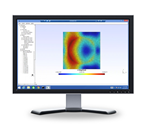Simulation software leveraged for rotor blade project
Seoul National University uses Analyswift’s composite simulation software, VABS, for more accurate design and analyses in the university’s experimental evaluation of a SNUF rotor blade.

Source | Analyswift, LLC
AnalySwift, LLC (West Jordan, Utah, U.S.), a provider of composites simulation software, announced on May 12 that Seoul National University is leveraging AnalySwift VABS software for the design and analysis work on the university’s composite helicopter rotor blades, including the Seoul National University Flap (SNUF) Blade. In 2019, the university joined AnalySwift’s Academic Partner Program, which offers participating universities no-cost licenses of the VABS and SwiftComp engineering software programs so that students, researchers,and faculty can use the tools in their research.
VABS is a general-purpose cross-sectional analysis tool for computing beam properties and recovering 3D stresses and strains of slender composite structures. It models composite helicopter and wind turbine rotor blades, as well as other slender structures, such as propellors, landing gear, high-aspect ratio wings and golf club shafts. VABS reportedly saves orders of magnitude in computing time without a loss of accuracy so engineers can consider more design options and arrive at the best solution quickly. This allows researchers to accelerate project completion while reducing costs.
“In our Active Aeroelasticity and Rotorcraft Lab (AARL) at Seoul National University, coupled analysis using computational structural dynamics (CSD) and computational fluid dynamics (CFD) is being conducted to verify for analysis/experiment correlations used to solve aeroelastic problems,” says Dr. SangJoon Shin, professor of aerospace engineering. “For example, rotorcraft aeroelastic analysis, CSD/CFD coupled analysis and multidisciplinary design optimization of the active rotor blade such, as active trailing edge flaps, are being studied. Furthermore, we study fixed aircraft flutter analysis for unmanned vehicles, as well as structural analysis for high-speed vehicles, launch vehicles and flexible structures for the bio-inspired flapping-wing micro air vehicle (FWMAV).”
One of AARL’s projects is an experimental evaluation on a Mach-scaled SNUF blade for active vibration control. The research group uses VABS along with other tools for its structural analysis and design verification, including calculating 2D cross-sectional analysis properties. VABS is also one of the tools used to calculate the structural safety margin. The researchers found the software program’s sectional analysis to be accurate when compared with more time-consuming and computer-intensive 3D analysis methods.
“VABS allows the multidisciplinary design of a composite rotor blade in a very short time,” Shin says. “We designed an active-trailing edge flap blade with glass- and carbon-fabrics with epoxy. The VABS analysis tool utilized in the design program predicted the mass and stiffness properties of the fabricated blade within 5% discrepancies.”
Related Content
-
The potential for thermoplastic composite nacelles
Collins Aerospace draws on global team, decades of experience to demonstrate large, curved AFP and welded structures for the next generation of aircraft.
-
Materials & Processes: Resin matrices for composites
The matrix binds the fiber reinforcement, gives the composite component its shape and determines its surface quality. A composite matrix may be a polymer, ceramic, metal or carbon. Here’s a guide to selection.
-
Plant tour: Albany Engineered Composites, Rochester, N.H., U.S.
Efficient, high-quality, well-controlled composites manufacturing at volume is the mantra for this 3D weaving specialist.
















